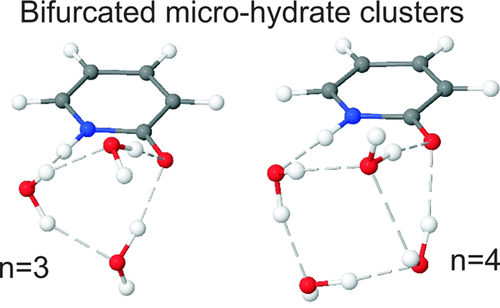当前位置:
X-MOL 学术
›
J. Phys. Chem. A
›
论文详情
Our official English website, www.x-mol.net, welcomes your feedback! (Note: you will need to create a separate account there.)
Transition from Water Wires to Bifurcated H-Bond Networks in 2-Pyridone·(H2O)n, n = 1–4 Clusters
The Journal of Physical Chemistry A ( IF 2.9 ) Pub Date : 2018-11-06 00:00:00 , DOI: 10.1021/acs.jpca.8b09410 Luca Siffert 1 , Susan Blaser 1 , Philipp Ottiger 1 , Samuel Leutwyler 1
The Journal of Physical Chemistry A ( IF 2.9 ) Pub Date : 2018-11-06 00:00:00 , DOI: 10.1021/acs.jpca.8b09410 Luca Siffert 1 , Susan Blaser 1 , Philipp Ottiger 1 , Samuel Leutwyler 1
Affiliation

|
Mass-selective two-color resonant two-photon ionization (2C-R2PI), UV/UV hole-burning, and infrared (IR) depletion spectra of supersonic jet-cooled 2-pyridone·(H2O)n clusters with n = 1–4 have been measured to investigate the local hydration patterns around 2-pyridone (2PY) as a function of cluster size. As shown by others, the IR frequencies of the OH and NH stretches of the n = 1, 2 clusters are characteristic of water wires stretching from the NH to the C═O group of 2PY. We identify two isomers (3A and 3B) of the n = 3 cluster in the 2C-R2PI spectrum and separate them by IR/UV and UV/UV hole-burning techniques. Isomer 3A exhibits a three-membered water wire, extending the n = 1, 2 structural motif. Isomer 3B exhibits bifurcated water wires with the first H2O donating to two waters that form H-bonds to the C═O group. This increases the H-bond strength between the NH group of 2PY and the proximal H2O molecule, lowering the NH stretch to ∼2800 cm–1. The n = 4 cluster is also bifurcated with two water wires between the bifurcating H2O and the C═O group. The cluster-selective IR spectra are complemented with density-functional calculations using the PW91, B3LYP, B97-D, and M06-2X functionals, where the latter two include long-range dispersive interactions, and with the ab initio correlated SCS-CC2 method. The calculated IR spectra provide firm assignments of the structures of the n = 1–4 cluster structures and allow us to understand the evolution of individual H-bond strengths with increasing cluster size.
中文翻译:

2-Pyridone·(H 2 O)n,n = 1-4簇中从水线到分叉氢键网络的过渡
超声速射流冷却的2-吡啶酮·(H 2 O)n n簇的n =的质量选择双色共振双光子电离(2C-R2PI),UV / UV空穴燃烧和红外(IR)耗尽光谱已经测量了1-4,以研究2-吡啶酮(2PY)周围的局部水合作用随团簇大小的变化。如其他人所示,n = 1、2个簇的OH和NH片段的IR频率是从NH到2PY的C = O基团延伸的水线的特征。我们确定了2C-R2PI光谱中n = 3簇的两个异构体(3A和3B),并通过IR / UV和UV / UV空穴燃烧技术将它们分开。异构体3A具有三元水线,延伸了n= 1、2个结构主题。异构体3B表现出分叉的水线,其中第一个H 2 O贡献给两个与C = O基团形成H键的水。这样可以增加2PY的NH基团与近端的H 2 O分子之间的H键强度,从而将NH的延伸降低至〜2800 cm –1。所述Ñ = 4簇也分叉与分叉h的两个水电线2 O与C = O基团。使用PW91,B3LYP,B97-D和M06-2X官能团进行密度-官能团计算,可对簇选择红外光谱进行补充,其中后两个包括长距离色散相互作用,并且具有从头算起相关的SCS-CC2方法。计算得出的红外光谱提供了结构的牢固分配n = 1-4团簇结构,使我们能够理解随着团簇尺寸的增加,各个氢键强度的演变。
更新日期:2018-11-06
中文翻译:

2-Pyridone·(H 2 O)n,n = 1-4簇中从水线到分叉氢键网络的过渡
超声速射流冷却的2-吡啶酮·(H 2 O)n n簇的n =的质量选择双色共振双光子电离(2C-R2PI),UV / UV空穴燃烧和红外(IR)耗尽光谱已经测量了1-4,以研究2-吡啶酮(2PY)周围的局部水合作用随团簇大小的变化。如其他人所示,n = 1、2个簇的OH和NH片段的IR频率是从NH到2PY的C = O基团延伸的水线的特征。我们确定了2C-R2PI光谱中n = 3簇的两个异构体(3A和3B),并通过IR / UV和UV / UV空穴燃烧技术将它们分开。异构体3A具有三元水线,延伸了n= 1、2个结构主题。异构体3B表现出分叉的水线,其中第一个H 2 O贡献给两个与C = O基团形成H键的水。这样可以增加2PY的NH基团与近端的H 2 O分子之间的H键强度,从而将NH的延伸降低至〜2800 cm –1。所述Ñ = 4簇也分叉与分叉h的两个水电线2 O与C = O基团。使用PW91,B3LYP,B97-D和M06-2X官能团进行密度-官能团计算,可对簇选择红外光谱进行补充,其中后两个包括长距离色散相互作用,并且具有从头算起相关的SCS-CC2方法。计算得出的红外光谱提供了结构的牢固分配n = 1-4团簇结构,使我们能够理解随着团簇尺寸的增加,各个氢键强度的演变。



























 京公网安备 11010802027423号
京公网安备 11010802027423号